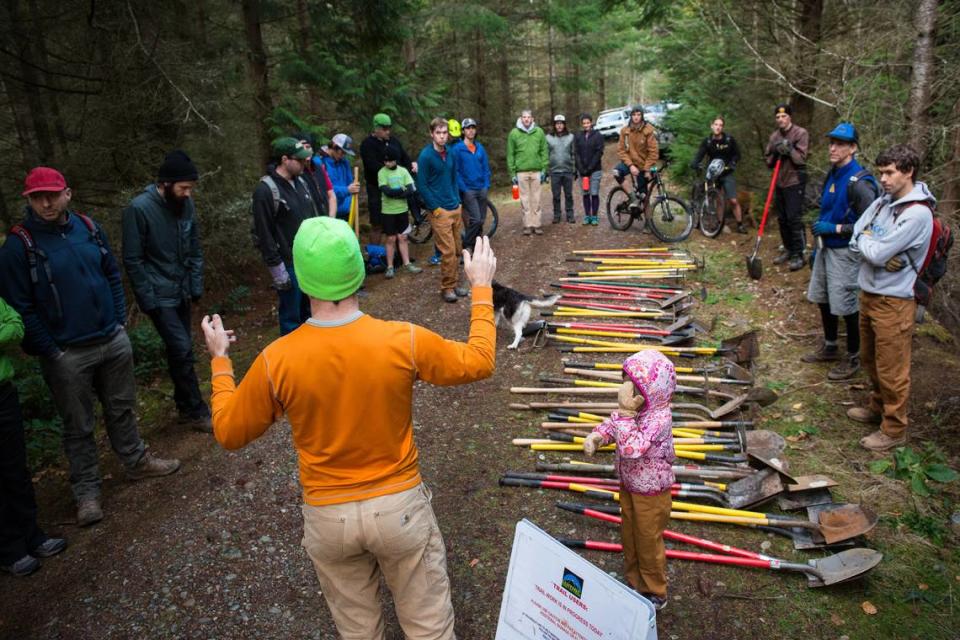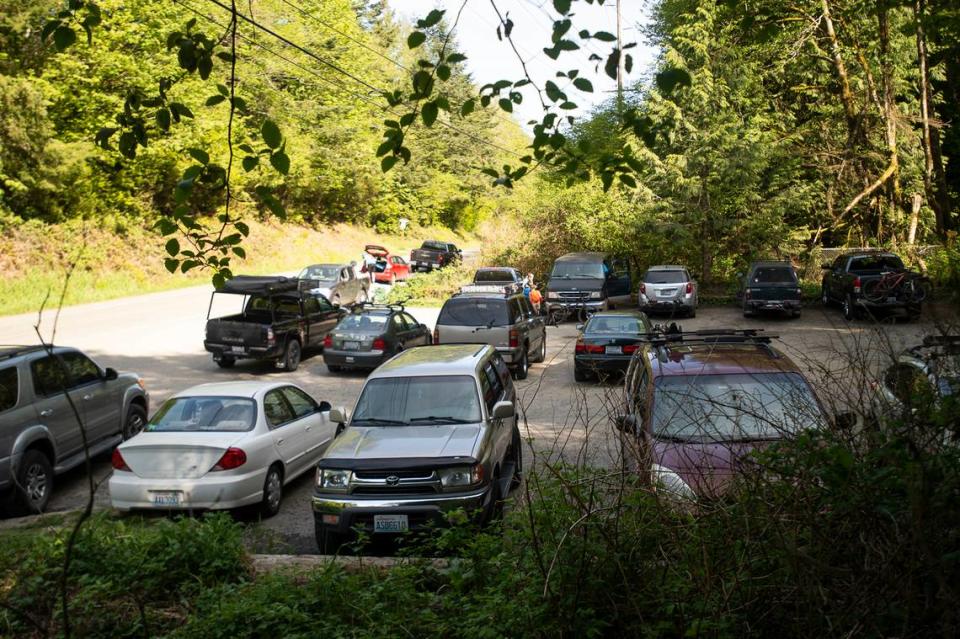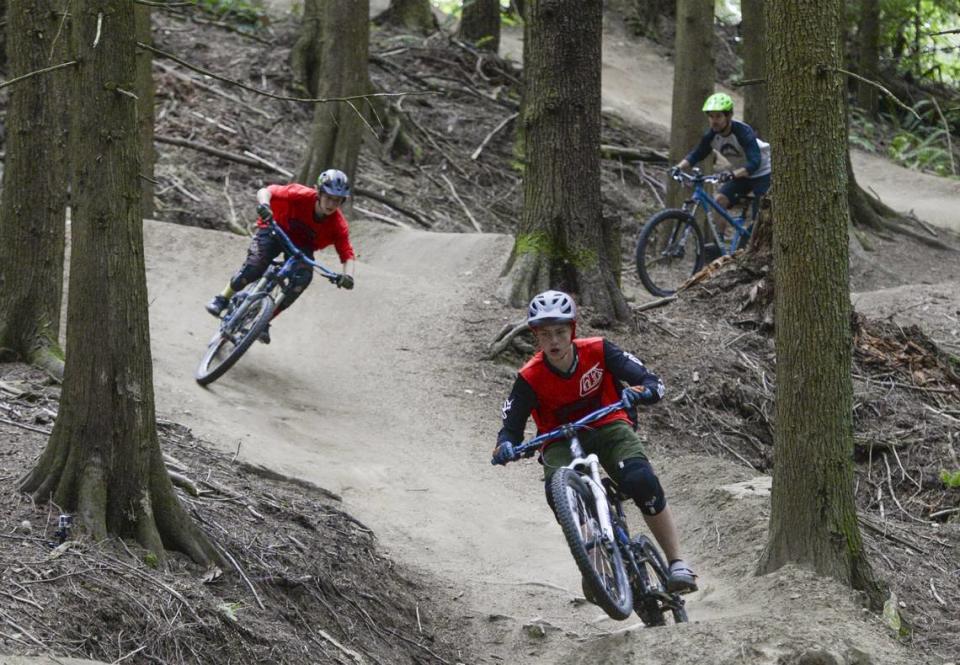How Bellingham became a hotbed for mountain biking
Every town has its summertime sporting rituals — a company softball league, pickup soccer night.
Bellingham is no different: Wednesday is race night. And in this Washington town, which has become a mountain biking hot spot, that means you bring your bike.
Thirty minutes after school let out on a Wednesday in May, three middle schoolers in helmets waited on a corner in a neighborhood with an upscale suburban feel. Across the street, an open garage door revealed an organized display of bikes and skis to rival an REI showroom.
When coach Emily Ford pedaled up the street, the members of team Radical Racers waved and picked up their mountain bikes. Ford greeted the girls, twins Johnny and Charly Eggert, 13, and Chiara Horton, 12. The quartet pedaled two blocks past well-manicured yards and high-end campervans in driveways until the homes abruptly gave way to the forest that blankets Galbraith Mountain. They steered their bikes around a gate that blocks vehicular access and followed a narrow trail snaking through the woods.
The group pedaled uphill over rocks and roots for 4 miles, stopping periodically for water breaks, and chatted casually about the school day. As the climb intersected with other trails — 65 miles of singletrack trail crisscross this 3,000-acre hillside — Ford recommended routes for future training rides on the same dirt where the U.S. Olympic team trained in 2016. Near the top, the trail emerged from the forest and into a clear-cut area, where the riders passed a series of death-defying dirt jumps known as Blue Steel, where local resident and professional mountain biker Hannah Bergemann hosts an annual worldwide invitational event for fellow women riders.
Ford told the Racers that if they progressed through the ranks of Radical Rippers — a mountain biking development program for kids 10-18 who self-identify as women, girls, nonbinary or gender nonconforming — Bergemann would coach them on how to tackle these so-called freeride features.
Bergemann herself was in Utah that week, one of a dozen top female mountain bikers from around the world tapped for an elite event called Red Bull Formation, where the bikers spend a week digging custom jumps and then launch off them. In seven years, she went from a Western Washington University freshman studying kinesiology to a career in mountain biking, working in the marketing department of local manufacturer Transition Bikes and traveling the world as a sponsored freeride biker.
From the after-school racing teams, to homes priced for trail access, to the cottage industry providing hundreds of jobs, to serving as home base for professional athletes on the world circuit, Bellingham has grown into an undisputed mountain biking hot spot — but one that remains close-knit.
“I came to Bellingham to go to college and got into biking,” Bergemann said via phone en route to Utah. “The community helped me hone in on this thing that I was able to take to a pro level. I wouldn’t have been able to do that anywhere else.”

Responsible, not renegade
Some 40 years after the first mountain bikers cut illegal trails, today Bellingham is home to 16 brick-and-mortar bike shops, two mobile bike shops, three bike brands with global distribution, a handful of mountain bike-accessory makers, 20 after-school bike clubs and quarterly magazine Freehub.
Mountain bikers who once blew through on Interstate 5 en route to the fabled trail networks of Vancouver’s North Shore and Squamish now stop for a few days, or even beeline to Bellingham without crossing the border at all. That ecosystem is dependent on the trails, well over 100 miles’ worth on the public and private land that rings Bellingham from Chuckanut Mountain to Blanchard Mountain to Lake Whatcom Park. Parents spend summer evenings watching their kids hone their skills at the city-run Waterfront Pump Track while sipping beers from Kulshan Brewing Company’s Trackside Beer Garden. Volunteers maintain a dirt jump park in the city’s Civic Athletic Complex, too.
“It’s been a slow burn,” said Whatcom Mountain Bike Coalition executive director Eric Brown, also known as the unofficial mayor of Bellingham, over breakfast. “But in the last half-dozen years it’s blown up.”
After watching how mountain bikers clashed with hikers in the sport’s birthplace in California’s Bay Area — where trail conflicts rage to this day — Bellingham’s early adopters resolved to take a different approach. Jim “Sully” Sullivan founded what became the WMBC in 1986 out of his house and led weekly rides and trail-building work parties. Members joined municipal parks and recreation advisory boards and sat on Washington Trails Association and Back Country Horsemen planning committees. They came across more as engaged citizens than as renegades on two wheels.
That spirit helped build goodwill to engineer compromises. Land managers’ default designation is to make every trail multiuse, but WMBC has successfully lobbied for certain trails to be downhill bike only, while in turn accepting that some routes, like the Rock Trail in Larrabee State Park, should not be open to bikes.
“In the end, no one on a bike wants to run over a kid,” Brown said.
Saving Galbraith
But just over 10 years ago, before the current mountain bike boom, the whole edifice threatened to crumble.
Bellingham’s crown jewel is Galbraith, a mere 1,785 feet high and carved up by logging roads. What this second-growth forest lacks in Cascadian grandeur it makes up in proximity: You can feasibly ride to a trailhead from almost anywhere in Bellingham.
WMBC, which painstakingly builds every trail from scratch mostly with volunteer hours and donations, sketched out a long-term plan for Galbraith in 2002 after signing a voluntary recreational access agreement with then-landowner Trillium Corporation.
But when Trillium turned Galbraith over to Polygon Financial Partners seven years later to pay off a debt, the relationship soured, as the new owner found mountain bikers to be a nuisance. In 2011, Polygon announced its intention to close off recreational access entirely, which would have punctured the tires of the Bellingham mountain bike scene just as it was picking up speed. Years of tense public meetings and negotiations followed as the city of Bellingham balked at Polygon’s $18 million asking price.
Finally, in 2017, Skagit County forestry industry veteran Rob Janicki made a deal with Polygon for $8 million to buy the mountain with the twin goals of maintaining recreation access while still harvesting some 50 acres per year. The next year, the city of Bellingham and Whatcom Land Trust paid $3 million for a recreation and conservation easement to keep the trails accessible in perpetuity.
Unlike trail networks on public land in mountain bike destinations like Moab, Utah, and Asheville, North Carolina, the end result means Bellingham mountain bikers are not entirely stewards of their own destiny. Mountain bikers in Vermont found out the hard way in late 2019, when landowners kicked them off a section of the Kingdom Trails. Brown insists the new owners work around existing trails and jumps, and also inform WMBC as soon as tree felling is finished so the organization’s full-time crew of three can clear slash piles and reopen trails.
“We have a level of communication that almost no trail organizations have with a logging company,” Brown said.

Cottage industry
While the north end of Galbraith abuts a neighborhood, the south end runs along busy Samish Way. Riders once parked in a cramped dirt lot then played chicken with speeding cars as they scurried across the road with their bikes. It was particularly unsafe for kids.
In May, WMBC unveiled a 184-stall paved parking lot for the south trailhead after raising $606,000 over five years. The county has promised a crosswalk.
The new lot will become a gateway for mountain bikers who don’t live within riding distance of Bellingham’s trails. And just up Samish Way there’s another new landmark: Last year, Transition Bikes opened Outpost, a 20,000-square-foot combination headquarters, full service bike shop, demo center and hangout space with food and drink.
“It’s the culmination of the dream,” said Transition co-owner Kevin Menard, who began building bikes out of his Haller Lake home in the early 2000s. In 2005, he and business partner Kyle Young moved the fledgling business from Seattle to Bellingham.
“In Seattle, the outdoors aren’t right there,” he said. “You always have to drive.”
In Bellingham, Menard rides from his house. That accessibility, closer proximity to the world-class trails in British Columbia and a lower cost of living all made the city appealing for a mountain-bike brand.
“We immediately folded into the community,” he said. “Bellingham is a growing city that retains a tight-knit community feel. It crushes on that front.”
Transition frames — as well as the other two local players, industry stalwart Kona and boutique brand Evil Bikes — are easy to spot around town, as are other wares from local brands, like inclusive sizing apparel maker Cosmic Dirt and hip packs from High Above.
“Bellingham is a great place for our business because it’s funky and weird and welcoming of lots of different types of people,” wrote Cosmic Dirt founder Ashley Duffus-Jambor via text. “It seems like every second person in this town rides bikes.”
For High Above founder JC Canfield, who parlayed years of outdoor industry sewing experience into bag making with a cult following in Japan, the calculation was simple when he moved the operation from his Fremont apartment to a Bellingham business park. “You make city stuff in the city and mountain stuff in the mountains,” he said.
As the town’s cottage industry around mountain biking grows — add custom fender maker Ground Keeper to the mix — Canfield began hosting a small business happy hour in April for local entrepreneurs to trade tips on navigating the struggles of domestic manufacturing.

Growing pains
For bike businesses big and small, Bellingham is an undeniable magnet.
“Bellingham is an amazing recruitment tool,” said Menard, whose company now employs 40 people.
But the boom has its drawbacks. With home prices climbing faster than a World Cup racer, the local real estate agent who donates $500 to WMBC for every closing has now contributed over $40,000 since 2016. That’s little consolation for Transition employees who have seen any dream of homeownership evaporate. Bike thefts are on the rise, too, with criminals wise to the investment worth thousands of dollars that many Bellinghamsters tote around.
Meanwhile, Canfield thinks local government has been too passive and coasts on volunteer enthusiasm. “This community is full of trail builders and they do it for free,” he said.
He views the city’s inability to buy Galbraith as “a missed opportunity” that should catalyze planning for future land acquisition. Bentonville, Arkansas, the self-proclaimed “Mountain Biking Capital of the World,” has been on an aggressive trail-building spree, albeit with the deep pockets of the Walton Family Foundation.
Ultimately, Canfield believes mountain biking deserves the same respect as the city’s lauded brewery scene, starting with a current economic impact study.
“(With breweries) they can see the gross receipts,” he said. “It’s harder to convert (the economic value of) somebody using a trail that they don’t have to pay for.”
In 2014, WMBC commissioned a rider survey that found one-third of respondents come from outside Whatcom County and spend at least $40 per trip at local businesses.
Race night
On that weekday in May, the Radical Racers finally reached a knob with views of snowcapped Mount Baker on one side, and on the other side, a thick stand of forest revealed the entrance to a downhill trail. A carved wooden owl guarded the entrance with the inscription, “You are not alone if there are trees.” The springtime afternoon sun gave way to a chilly windswept evening and the girls bundled up in layers. Adult racers, most in mountain bike gear and a few in costume — a NASA spacesuit, a Lorax jersey — and kids wearing chest and knee pads milled about while volunteers checked in competitors at a folding table.
By 5:30 p.m., over 200 people, nearly every one straddling a full-suspension mountain bike, clustered in the clearing. Standing atop a stump and wearing a red flannel shirt that said “Save the Trails,” WMBC’s Brown asked the question the crowd had been waiting for all winter.
“Is everybody ready for the Whatcom World Cup?” he bellowed. They answered with a cheer.
Ford gathered her athletes for a final huddle. She went over goals for the race: maximize speed and traction, keep eyes up, pedal when needed, pump to maintain momentum, lean into corners, enter wide and exit shallow on banked turns called berms.
“Have fun, be in control and try not to crash,” she said.
When their start came, the Eggert twins and Chiara each took off in 30-second intervals down a trail called SST to pedal, steer and brake as fast as they could, riding over 1.3 miles and down 670 vertical feet with views of Bellingham Bay in the distance.
Halfway down SST, where it intersects with a logging road, volunteers in Cosmic Dirt trucker hats had erected pop-up tents and fired up grills to serve hot dogs and veggie dogs to hungry racers and spectators. Kulshan Brewing donated cases of hazy IPA and Mexican lager.
Ford and her athletes debriefed after the race, comparing notes on tricky corners and body weight placement. Someone blew a horn each time a racer zoomed by and they looked up to cheer.
Eventually, they rode back downhill the way they had come up and headed inside to finish their homework. Until summer break begins, the Whatcom World Cup still falls on a school night.

